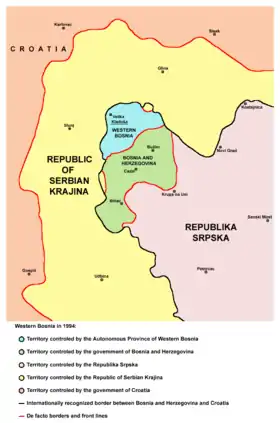| Inter-Bosnian Muslim War | |||||||
|---|---|---|---|---|---|---|---|
| Part of the Bosnian War | |||||||
 Map of the Bihać enclave (under the control of the Bosnian-Herzegovinian government), surrounded by the Republic of Serbian Krajina (in the northwest), the Autonomous Province of Western Bosnia (to the north) and the Republika Srpska (to the southeast) | |||||||
| |||||||
| Belligerents | |||||||
|
Supported by: |
| ||||||
| Commanders and leaders | |||||||
|
|
| ||||||
| Units involved | |||||||
|
| |||||||
| Strength | |||||||
|
NOZB: VRS: RSK: |
ARBiH: | ||||||
| Casualties and losses | |||||||
| Unknown | 1,700 soldiers killed | ||||||
Inter-Bosnian Muslim War refers to a civil war fought between the Army of the Republic of Bosnia and Herzegovina and the Autonomous Province of Western Bosnia from 1993 to 1995.
Background
The Cazinska Krajina region located in the wider region of Bosanska Krajina enjoyed somewhat higher GDP per capita compared to the average of the Socialist Republic of Bosnia and Herzegovina.[3] The region was populated mostly by Bosnian Muslims and includes the municipalities of Bihać, Cazin and Velika Kladuša. On its north and west, it borders Croatia and is cut off from the rest of the Bosnian Muslim population in the south and east by the densely populated Serb areas.[4] Fikret Abdić established a local agricultural company Agrokomerc based in Velika Kladuša and during the 1970's and 1980's managed to transform Cazinska Krajina into a successful regional economy, previously a poor peasant area. Agrokomerc became the largest food-processing conglomerate in Yugoslavia, employing 13,000 people and owning many factories and outlets. The whole town of Velika Kladuša and the surrounding area lived because of Agrokomerc's success. Abdić managed to create a personalty cult, being nicknamed "Babo" (English: Daddy).[5]
The Bosnian War came to Cazinska Krajina in May 1992, with the unsuccessful effort from the Bosnian Serb army to occupy Bihać. Although Cazinska Krajina was constantly surrounded by the Bosnian Serb forces, the fighting deescalated in the early month of 1993, especially after Bihać was proclaimed a safe area in April 1993.[4]
History
Fikret Abdić, the Muslim Member of the Presidency of the Republic of Bosnia and Herzegovina and the local leader who created an economic empire around Agrokomerc, declared the Autonomous Province of Western Bosnia on 27 September 1993 in Velika Kladuša. The AP Western Bosnia operated as a mini-state, with a prime minister and a parliament.[4] The Bosnian Muslims from Bihać opposed the autonomy and took the Sarajevo line. At the time when the Bosnian Muslims were in an open war with the Bosnian Serbs and Bosnian Croats, Fikret Abdić signed a pact of cooperation with the Bosnian Serb Republika Srpska in October 1993 and an agreement on the development of political cooperation with Republika Srpska and the Croatian Republic of Herzeg-Bosnia in November 1993. Abdić enjoyed strong local support.[6] The 521st and 527th brigades of the 5th Corps of the Army of the Republic of Bosnia and Herzegovina from Velika Kladuša defected and joined Abdić.[7]
The Bosnian Muslims who sided with the Sarajevo line around Alija Izetbegović were led by Atif Dudaković, the commander of the 5th Corps of the Army of the Republic of Bosnia and Herzegovina. Cazinska Krajina was split between Abdić and Dudaković, with Velika Kladuša and Cazin siding with Abdić and Bihać with Dudaković. By January 1994, most of the territory of Cazinska Krajina was under the control of the 5th Corps. The same month Dudaković signed a ceasefire with Abdić. However, the ceasefire was broken on 18 February 1994 when Abdić started an offensive against the 5th Corps. The fighting lasted till the summer of 1994, and by the end of the conflict, 30,000 of Abdić's forces were fleeing towards neighbouring Croatia. Although the 5th Corps attained several victories, in December 1994, Velika Kladuša was once again under Abdić's control. The 5th Corps managed to break through Serb lines around Bihać, and strengthen with the Bosnian Muslim-Croat Washington Agreement of 1994, managed to achieve decisive victories against Abdić's army.[6]
Footnotes
- ↑ Michael R. Gordon (30 November 1994). "Conflict in the Balkans: Croats Warn of Wider War if Bihać Falls". The New York Times. Retrieved 16 February 2013.
- ↑ Tom Hundley (30 July 1995). "Croatia, Serbia Face Off at Bihac". Chicago Tribune. Retrieved 10 March 2013.
- ↑ Fotini 2008, p. 463.
- 1 2 3 Fotini 2008, p. 467.
- ↑ Fotini 2008, pp. 469–470.
- 1 2 Fotini 2008, p. 468.
- ↑ Fotini 2008, p. 469.
Bibliography
- Fotini, Christia (2008). "Following the Money: Muslim versus Muslim in Bosnia's Civil War". Comparative Politics. 40 (4): 461–480. Retrieved 28 November 2023.